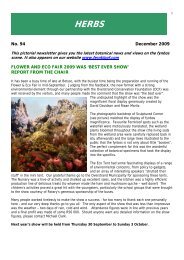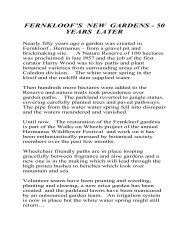History of Fernkloof - Fernkloof Nature Reserve
History of Fernkloof - Fernkloof Nature Reserve
History of Fernkloof - Fernkloof Nature Reserve
Create successful ePaper yourself
Turn your PDF publications into a flip-book with our unique Google optimized e-Paper software.
FERNKLOOF TURNS<br />
FIFTY<br />
Some call it the best kept secret in the Cape; for botanists it is<br />
one <strong>of</strong> the ‘hottest’ <strong>of</strong> the Cape Floral Kingdom ‘hotspots’. Either<br />
way, Fernklo<strong>of</strong> <strong>Nature</strong> <strong>Reserve</strong>, turning 50 in 2007, is a very<br />
special asset to the coastal resort <strong>of</strong> Hermanus.<br />
In 1957 only the mountains were the same. There were no stone<br />
buildings housing herbarium, <strong>of</strong>fice and lecture hall, no visitors’<br />
centre to inform and direct – and most important, no graded<br />
paths to lead visitors through the fynbos splendours. Inside<br />
the present entrance a gravel pit and brickmaking site scarred<br />
the hillside.<br />
Beside the bokkie and baboon population, only some intrepid<br />
farmers drove their sheep over the mountain in search <strong>of</strong> fresh<br />
grazing, braving the odd predatory lynx and leopard.<br />
.
Driving force behind the establishment <strong>of</strong> a nature reserve came<br />
from the Mayor <strong>of</strong> Hermanus, Otto Prillewitz, who in late l957<br />
persuaded the municipality to allot 100 hectares to this project<br />
The sundial in front <strong>of</strong> the Botanical Centre pays tribute to the<br />
man responsible for the Fernklo<strong>of</strong> <strong>Nature</strong> <strong>Reserve</strong>.<br />
“First curator was Harry Wood,” says Frank Woodvine, former<br />
curator <strong>of</strong> the reserve and now a member <strong>of</strong> the Fernklo<strong>of</strong><br />
Advisory Board in his retirement. “His job was to create a<br />
garden with plants native to the Caledon division. But such was<br />
his enthusiasm that trees and flowers from as far away as<br />
Eastern Cape and Natal were introduced – even a thriving<br />
bauhinia from India!”<br />
Rockeries, flowerbeds, paths and ponds were laid out and<br />
enjoyed by everyone. A pipeline was installed to bring water<br />
from the Rockfill Dam.<br />
A small nursery on the gravel pit site was established to grow<br />
the required plants. Water came from a well just behind where<br />
the Botanical Centre now stands.<br />
Harry Wood (not to be confused with the Stanford farmer <strong>of</strong> the<br />
same name who was a member <strong>of</strong> the Fernklo<strong>of</strong> Advisory Board<br />
in the l980’s) travelled daily from his small isolated cottage at<br />
Rooiels to Fernklo<strong>of</strong>.<br />
As he was only paid a hundred pounds a month, petrol must<br />
have been a lot cheaper then! Later a curator’s cottage was built<br />
but Harry’s <strong>of</strong>fice-cum-workshop was a donated wooden shed<br />
until the Botanical Centre was built in the late l970s. Quote for<br />
the Fernklo<strong>of</strong> Hall in 1980 was R1100,00. The toilet block built<br />
about four years ago cost R100 000.<br />
With the gardens in place, attention switched to the laying out <strong>of</strong><br />
graded paths in the reserve itself. It was the start <strong>of</strong> a close<br />
working relationship between the Hermanus Botanical Society,<br />
municipal management and the Fernklo<strong>of</strong> Advisory Board<br />
The late Dr Ion Williams, well-known botanist and Freeman <strong>of</strong><br />
Hermanus, was responsible for the layout <strong>of</strong> the paths and much<br />
<strong>of</strong> the work, utilising his skills as a civil engineer.<br />
In l971 the reserve was increased by Council from 100 to 1440<br />
hectares. The gardens were allowed to lapse into jungle status<br />
while all energies were directed to laying out more trails and<br />
keeping the infestation <strong>of</strong> alien vegetation in check.
In addition to the Botanical Centre, built by the Hermanus<br />
Botanical Society, a small Visitors’ Centre was built further up<br />
the road where the present one now stands. A display <strong>of</strong><br />
flowers is renewed weekly by a special picking team. On top <strong>of</strong><br />
Galpinkop, all <strong>of</strong> 596m high, an overnight hut snuggles against<br />
the summit, also built and maintained by the society.<br />
The herbarium has been given international status and houses<br />
1600 montane and coastal species, more than in the entire<br />
United Kingdom. The nursery has expanded into a thriving<br />
business also run by the society.<br />
At present the reserve encompasses nearly 2 000 hectares with<br />
its boundaries including the Mossel River and most <strong>of</strong> the Cliff<br />
Path. It enfolds the town <strong>of</strong> Hermanus in an ec<strong>of</strong>riendly<br />
embrace.<br />
More than forty rare and endangered species abound on the<br />
mountains and coast. Botanists the world over come to visit<br />
the giant carnivore Roridula gorgonias which grows in pinkflowered<br />
pr<strong>of</strong>usion on the banks <strong>of</strong> a high-flowing stream. Its<br />
purple-red sticky leaves colour its habitat.<br />
Creamy Cyrtanthus leucanthus flowers along the lower<br />
Klipspringer trail together with the rare ground protea, Protea<br />
angustata, camouflaged a s<strong>of</strong>t apple green. Half a healthy<br />
stand <strong>of</strong> the latter was left hanging over a new roadside cliff<br />
when bulldozers moved in to make a new road, but it is<br />
recovering.<br />
Brachysiphon rupestris hangs from a rocky crevice on Hoy’s<br />
Koppie, also part <strong>of</strong> the reserve. Another bright pink bloom is<br />
the graceful Cliff Lily, Gladiolus carmineus, found only in this<br />
area.
Also endemic to Fernklo<strong>of</strong> is the sticky red and white tubular<br />
erica called the Pride <strong>of</strong> Hermanus, Erica aristata<br />
It grows high on Galpinkop, together with another special<br />
species, the yellow Erica galpinii. The list goes on and on.<br />
Although management <strong>of</strong> this big area is an ongoing problem at<br />
present, the story <strong>of</strong> the abandoned gardens has had a happy<br />
ending (or beginning). Four years ago, with the advent <strong>of</strong> an<br />
aloe garden, then a fragrance garden, a combined Wildflower<br />
Festival project <strong>of</strong> wheelchair friendly paths and restored<br />
gardens went into top gear.<br />
Land leased by the society was extended to cover the garden<br />
area.<br />
While the paths went into construction, quantities <strong>of</strong> senescent<br />
bush and kikuyu grass were hacked away. An irrigation system<br />
was installed, a garden service employed to cut the lawns, and a<br />
dedicated garden team <strong>of</strong> volunteers established erica, protea,<br />
bulb and healing plant gardens in quick succession.<br />
In the process dry stone walls <strong>of</strong> Harry Wood’s vintage, ponds<br />
and old paths have been uncovered. His trees are now 20m high<br />
in some cases and his Indian bauhinia is still flourishing. Rest<br />
well, Harry, your garden is again in loving hands.<br />
Geraldine Gardiner<br />
Photographs: Christine Wakfer







